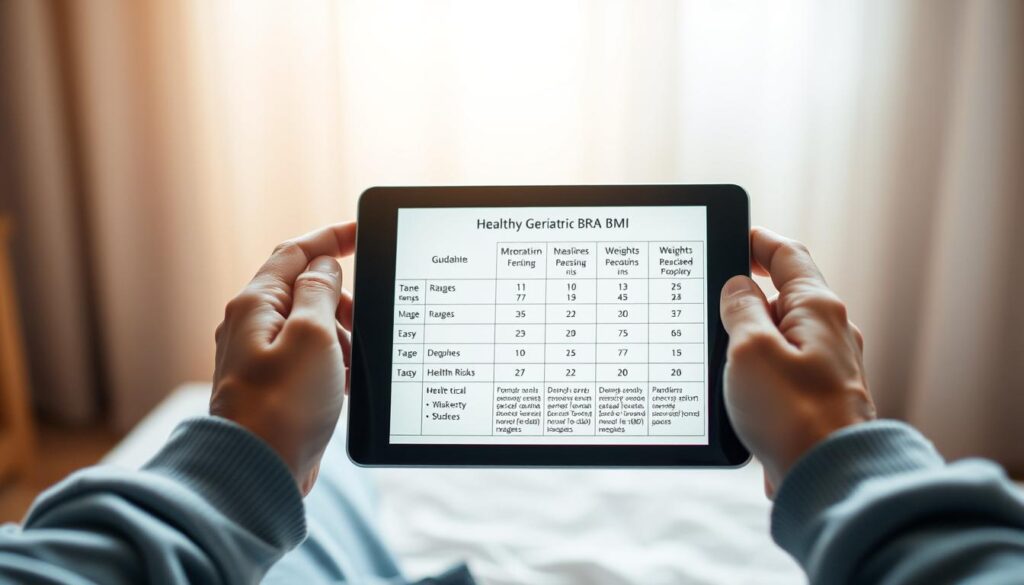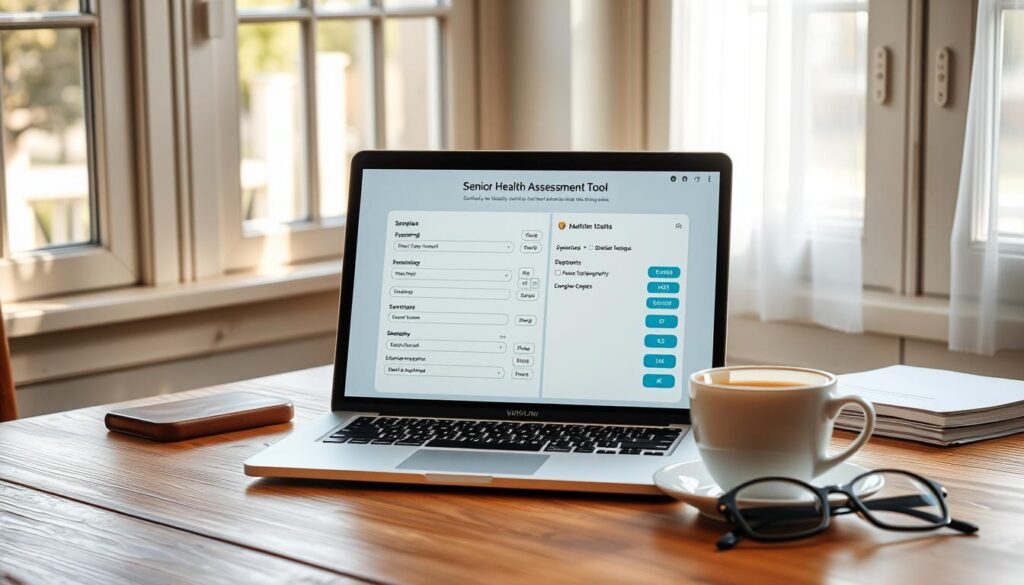How often do we consider how body composition changes impact long-term wellness after 60? At our core, we believe informed choices start with accessible tools. That’s why we designed the Maine senior weight calculator – a tailored resource combining height, age, and mass index data to evaluate wellness benchmarks for older adults.
Body Mass Index (BMI) remains a widely recognized starting point for assessing health risks linked to obesity or being underweight. According to the National Center for Chronic Disease Prevention and Health Promotion, nearly 40% of U.S. adults over 60 face obesity-related challenges. Our tool simplifies this metric, letting users input measurements to generate personalized results.
However, BMI alone doesn’t account for muscle mass or bone density. While our calculator provides actionable insights, we always emphasize consulting healthcare professionals. For example, men can explore deeper analysis using our BMI calculator for adult males, which addresses gender-specific factors.
Key Takeaways
- BMI offers a baseline to identify potential health risks tied to weight fluctuations.
- Age-related body changes require tools adapted for senior-specific needs.
- Professional guidance remains critical when interpreting BMI results.
- Government-endorsed formulas ensure reliable calculations in our tool.
- Combining BMI with other health metrics creates a fuller wellness picture.
Understanding BMI and Healthy Weight for Seniors
For older adults, maintaining a healthy weight involves more than just numbers on a scale. Body composition shifts with age—muscle mass decreases, while fat distribution changes. This makes BMI a valuable starting point, though not the full story.
Why BMI Remains Relevant After 60
Body mass index helps identify potential health risks linked to extreme weight levels. Research shows adults over 60 with a BMI below 22 face higher risk of malnutrition and bone fractures. Conversely, those above 30 may experience exacerbated joint issues or heart disease.
Standard vs. Geriatric BMI: Key Adjustments
Traditional BMI categories don’t fully address aging bodies. Geriatric guidelines suggest slightly higher ranges for optimal health:
| Category | Standard BMI | Senior-Adjusted BMI |
|---|---|---|
| Healthy Range | 18.5–24.9 | 22–27 |
| Obesity Threshold | ≥30 | ≥30 |
| Underweight Risk | <18.5 | <22 |
This adjustment reflects studies showing modestly higher BMIs may protect against energy depletion during illness. However, accuracy matters—always measure height without shoes and weight on a calibrated scale.
While our tool simplifies these calculations, individual factors like chronic conditions or mobility levels require professional interpretation. Government health agencies endorse these ranges, ensuring reliable benchmarks for older populations.
How to Use Our Maine senior weight calculator
Getting precise results starts with proper technique. Our tool simplifies health evaluation through three straightforward steps, accommodating both imperial and metric measurements. Let’s walk through the process to ensure clarity and accuracy.
Step-by-Step Guide to Accurate Inputs
- Select Measurement Units: Choose between pounds/feet or kilograms/meters using the toggle switch
- Enter Current Data: Input your latest height (without shoes) and weight (measured in the morning)
- Review and Submit: Confirm numbers match your physical measurements before clicking “Calculate”
The built-in converter automatically adjusts values if you mix units. For instance, entering 160 centimeters and 150 pounds triggers instant recalculation to maintain consistency.
Optimizing Measurement Precision
Follow these practices for reliable results:
- Use a digital scale on hard flooring – carpeting can distort readings by up to 10%
- Stand straight against a wall when measuring height, with heels touching the baseboard
- Update inputs seasonally – natural weight fluctuations occur throughout the year
| Measurement | Common Errors | Best Practices |
|---|---|---|
| Weight | Weighing after meals | Measure before breakfast |
| Height | Slouching during measurement | Use a book/spirit level on head |
| Age Input | Using approximate age | Enter exact birth year |
While our system flags obvious outliers, always verify your entries. Government health portals recommend retesting weekly for trend analysis. Remember, these insights complement – but don’t replace – professional medical advice.
Interpreting Your Maine senior weight calculator Results
Health indicators like BMI take on new significance after 60, requiring tailored interpretation. Our tool provides personalized insights, but understanding their implications demands context. Let’s explore how to translate numbers into actionable health strategies.
Translating Numbers into Health Insights
Your calculated value falls into one of three categories adjusted for aging bodies:
- Below 22: May indicate undernutrition risks or reduced energy reserves
- 22–27: Considered optimal for maintaining bone density and illness recovery
- Above 27: Suggests potential cardiovascular strain if paired with high body fat
Muscle loss common in older populations can skew results. A 70-year-old with a BMI of 26 might have different health risks than a 30-year-old with the same score due to body composition changes. Chronic conditions like arthritis or diabetes further influence how these ranges apply individually.
Government health portals emphasize:
“BMI serves as a screening tool, not a diagnostic measure. Always combine it with waist circumference and bloodwork for comprehensive analysis.”
We recommend cross-referencing your results with resources from .gov websites like the CDC’s Healthy Aging portal. These platforms offer percentile charts comparing your metrics to national averages for similar age groups.
Three steps for practical application:
- Compare your result against senior-specific ranges
- Note any existing conditions affecting weight or muscle mass
- Schedule a care provider consultation to discuss findings
Remember: Tools empower, but human expertise transforms data into health victories. Use your calculated insights as conversation starters with professionals who understand your unique history.
Healthy Aging and Weight Management Strategies
Aging well involves more than numbers—it’s about sustainable habits that nurture body and mind. Combine nutrient-rich meals with movement adapted to your mobility level. Even gentle activities like chair yoga or walking improve strength and heart health, as noted on .gov health portals.
Regular check-ins with your BMI calculator help track changes in body composition over time. Pair these insights with blood pressure checks and discussions about body fat percentages. Early detection of shifts allows timely adjustments to your wellness plan.
Set achievable targets, like adding one vegetable-rich meal daily or increasing hydration. Government studies show consistent, small changes create lasting benefits. Always consult healthcare providers to align these steps with your medical history.
Remember: Our tool offers guidance, not prescriptions. Share your progress with local senior centers or online communities for added motivation. Together, we build health strategies that celebrate life’s later chapters.



